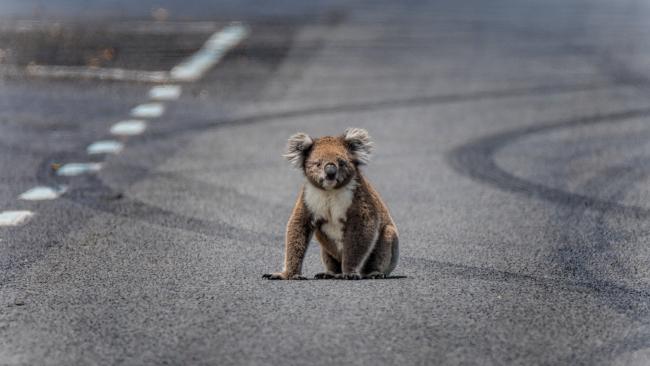Shocking statistic Australia should be ashamed of
There’s a reason Australian native wildlife is so vulnerable. And it’s up to us all to help save our iconic species.

Pets and Wildlife
Don't miss out on the headlines from Pets and Wildlife. Followed categories will be added to My News.
Brought to you by WWF Australia, Australian Conservation Foundation, The Wilderness Society, Birdlife Australia and Humane Society International
AUSTRALIA IS THE OLDEST CONTINENT
Darren Grover is the Head of Healthy Sea and Landscapes at WWF and said many Australians don’t understand just why our wildlife is so susceptible to becoming endangered or even extinct.
“Australia became an island millions of years ago. So things here are found nowhere else on Earth. Which makes them very vulnerable. Once we lose them, that’s it.”
He explained enormous changes started happening to our land as soon as European settlers arrived. “People had come from the northern hemisphere, and this was a strange land to them. They tried to apply a European sensibility - clearing bushland for farming and development. “Australia was such a large country and people thought ‘what I do doesn’t matter’. (It was) a real sense of naivety.”
He said not only was land clearing a problem, but invasive species such as rabbits, foxes, and feral cats were introduced and quickly had a huge impact on native wildlife.
“There was a growing sense from the 1880s that wildlife that was once common was now no longer seen. But the government was still incentivising people to clear land for development. They had to keep clearing.”
Mr Grover said environmental awareness has been growing since this time, marked by tragic occurrences, such as the extinction of the once-common Thylacine (or Tasmanian Tiger).
He said while there is much more awareness in modern Australia of the need to protect our wildlife, market forces are still pushing increased demands on the land, which affects our native animals.
“There is an increased intensity of agricultural development. So instead of having 100 cows you have 1000 cows. That can have a short term economic benefit but it has a long term destructive impact on our wildlife and ecosystems.”
THE PROBLEM WITH PATCHY AREAS OF PROTECTED BUSHLAND
Mr Grover said that while Australians were hugely active in protecting our vulnerable rainforest areas such as the Daintree and the Tasmanian Wilderness in the 80s, it’s now our dry Eucalypt forests in critical danger. Not only is this environment vulnerable to fire, as we’ve tragically witnessed recently, but it’s land used for agriculture and forestry.
“Our dry eucalypt forests are where the fights are - this is where koalas live. These forests appear to be endless” Mr Grover said.
“But what we’ve seen over 200 years is these forests aren’t endless. Where they still remain they’re fragmented - and wildlife can’t move across a landscape.” He explained that animals such as koalas need to move in Spring, as it’s breeding season. With vast space between trees, they’re forced to walk on the ground.
This is dangerous not only because they may have to cross a road, but because they’re much more vulnerable from prey. “Moving across the landscape where trees are far apart can be pretty dangerous business for a koala.”
Mr Grover said it’s not only koalas that have faced huge threats to their habitat recently.
He is also particularly worried about the greater glider, Australia’s largest gliding marsupial.
“It’s interesting that they’ve flown under the raider for so long - they should be as iconic as koalas. They inhabit eucalypt forests throughout Eastern Australia.”
He said the combination of fragmentation, logging, and fires contribute not only to the loss of habitat but also a degradation in the quality of habitat that remains. “The greater glider needs those really big old trees that have hollows where they can live and raise their young. Those are the trees lost by fires and logging. It’s a sad story, but we need to fight for awareness. They’re a spectacular species we should know more about.”
WHY EVERY AUSTRALIAN NEEDS TO ACT NOW
As part of the Places You Love Alliance, WWF-Australia along with other conservation organisations, such as the Wilderness Society and the Australian Conservation Foundation, is pushing to change our national environment laws, so we can give species like the koala a greater chance at survival.
“The EPBC Act (Environment Protection and Biodiversity Conservation) is over 20 years old now. It’s no longer achieving what it’s designed to do.” He said the group is pushing for consistent national environmental standards and an independent regulator to ensure all landholders are complying with the law.
“There’s a large number of landholders, and simply not enough regulators to enforce the Act. That doesn’t mean that farmers aren’t doing the right thing, but we simply don’t know what’s happening. We need more resources.”
He said the Alliance is calling on Australians “to raise their voices.” “Write to your local member, sign the petitions, get your voice heard. Our wildlife is important to us. It’s unique. Every Australian has to play a role to protect our wildlife and environment.”
Brought to you by WWF Australia, Australian Conservation Foundation, The Wilderness Society, Birdlife Australia and Humane Society International



